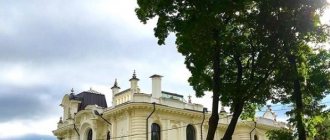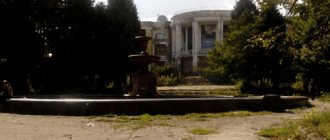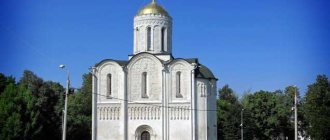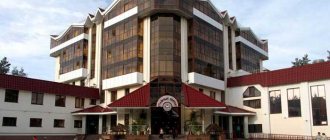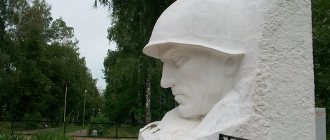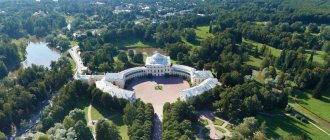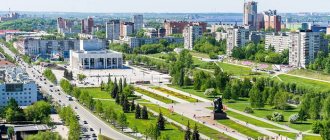In the central part of the East European Plain, on the Central Russian Upland, the small Tula region is located. The nature of this region is impressive with its splendor: clearings (stripes of forest) give way to river valleys, sandstones to lush greenery, and natural wonders to man-made monuments and tourist sites. It’s worth seeing the beautiful places of the Tula region at least once to understand: Russian people don’t need any foreign countries, because “over there” everything is foreign and cold, albeit beautiful, but here it’s our own, dear, real!
Quarries on the Sturgeon River
Byakovsky, or, in other words, Guryevsky, quarries are separate systems of underground passages stretching for a distance of 70 to 150 km along the bank of the Sturgeon River. Back in the 15th and 16th centuries, limestone was mined here by prisoners. But the stone turned out to be of poor quality, so the mine was closed. A cave less than 1 km long appeared in that place. In 1946, it was filled up, but a man who remained unknown cut a “window” into the quarry by simply digging a ventilation hole. Since then, there have been a lot of people in this beautiful place in the Tula region.
Byakovsky quarries.
0
The Guryev (Byakovsky) quarries located in the Tula region are a place with a long history, their length ranges from 70 to 150 km. The Byakovsky quarries consist of separate systems of underground passages located on the banks of the Sturgeon River: Red Dogs, Pants, Black System and White System. Back in the 15th–16th centuries. On the right bank of the river, prisoners mined limestone, but due to the poor quality of the stone, mining was stopped. Since then, a cave less than 1 km long has formed in that place. From the 16th century Limestone mining began on the left bank of the river; development continued until the beginning of the 20th century. In 1946, the resulting cave was filled up, but an unknown person dug out a ventilation hole, through which it is now possible to enter the famous place - the Byakosvka quarries.
0
Ishutinskoye settlement
An amazingly beautiful place in the Tula region for walking by car. It is covered with many different myths and legends. They say that a long time ago there was a city here, which the Crimean Tatars were never able to take. It’s just that when they arrived, people disappeared somewhere, leaving behind only glowing coals in the stoves, and this happened repeatedly. It is worth noting that the answer has not yet been received. No secret caves where city residents could go have yet been discovered. The settlement is washed by a river with a stunning name - the Beautiful Sword.
Armored train "Kozma Minin"
Visiting the beautiful places of Tula and the Tula region and not visiting the Chern railway station is a big omission. After all, here you can touch the history itself - see a real armored train, which at one time was an example of armored vehicles. It is installed on the site where the commanders of the 31st special Gorky division once died.
All Saints Cathedral in Tula
All Saints Cathedral, Tula. Photo: Boris Breytman / photobank “Lori”
The wooden All Saints Church in Tula appeared in 1773. It was laid in the “plague” cemetery, where those killed during the plague epidemic in 1771–1773 were buried. In 1776, a spacious stone church began to be built on the site of the wooden church.
It was built in several stages. First, the lower church was consecrated in honor of All Saints, and in the late 1780s, at the expense of the Tula merchant Nikifor Devyatkin, the upper one, the Church of the Transfiguration of the Lord, was completed.
In 1790, during the liturgy, one of the five domes of the temple collapsed. Several parishioners died, and the Church of the Transfiguration was closed for five years. The reconstruction of the destroyed part ended in 1797, and the temple was reconsecrated only in 1825.
In 1863, a three-tier bell tower was built next to the church according to the design of Carl Rossi’s student Vasily Fedoseev. It reached a height of 82 meters - higher than the Spasskaya Tower of the Moscow Kremlin.
From 1923 to 1944, the All Saints Church was the main temple of the Tula Renovationists, a schismatic movement of the Russian Orthodox Church. Since 1945, the temple has become the cathedral of Tula. It was restored in the 1990s.
The abandoned estate of the von Meck family
The estate located in Khruslovka once belonged to the king of the Russian railway, Karl von Meck. And although the entrepreneur himself was practically forgotten, his wife will forever remain in history. After all, one of P. I. Tchaikovsky’s works was written in her honor. Despite the fact that the estate survived the revolution, it is now in terrible condition. However, this does not make it any less beautiful and grandiose.
Museum-reserve "Kulikovo Field"
When listing the beautiful places of the Tula region, it is impossible to miss the Kulikovo Field Museum-Reserve, which covers 5 different places: the legendary battlefield, Monastyrshchino, Tula, Epifan and Red Hill. Around this area in 1380, Prince Dmitry Donskoy, together with his warriors, won the first victory over the Mongol Tatars. And even though Rus' finally got rid of the yoke only after 100 years, that battle will forever remain in the memory of the people. Currently, it houses a military history museum and a nature reserve. You can visit the complex as part of an excursion group or on your own, including by car.
Kulikovo field
Obelisk to Dmitry Donskoy on the Red Hill of Kulikovo Field, Tula region. Photo: Natalya Ilyukhina / photobank “Lori”
On the territory of the Tula region, on the banks of the Don River, there is the Kulikovo Field - the place where on September 8, 1380, a battle took place between the Moscow prince Dmitry I Ivanovich and the Golden Horde commander Mamai. For his victory in the Battle of Kulikovo, Dmitry I received the nickname Donskoy.
It was decided to create a museum on Kulikovo Field only in the 19th century. It was proposed by historian and amateur archaeologist Stepan Nechaev to open it. In his Polibino estate in the Ryazan province (now Lipetsk region), Nechaev opened the first museum of the Battle of Kulikovo. In it he placed sabers, chain mail, spear and arrowheads and other archaeological finds.
In 1850, an obelisk was installed on the Red Hill of Kulikovo Field - a black cast-iron column with a golden dome and a cross. The project was prepared by the artist and architect Alexander Bryullov. And at the beginning of the 20th century, the Temple of Sergius of Radonezh was erected here. According to legend, it was this saint who blessed Dmitry Donskoy for the battle. The design of the temple was created by Moscow architect Alexei Shchusev. The building is reminiscent of Russian pre-Petrine churches, and one of the domes repeats the shape of military helmets of the 14th century.
During the Great Patriotic War, the obelisk was destroyed, and the icons and iconostasis were removed from the temple. Restoration of the complex began in the 1960s, and in 1996 a museum-reserve was created here. Its exposition is located not only in the complex on the Kulikovo Field itself, but also in other branches - in the village of Monastyrshchino, the village of Epifan. Permanent exhibitions are dedicated to the history of the Kulikovo Field, as well as the Battle of Borodino, Prokhorovsky and other major battles in Russian history.
Estate "Yasnaya Polyana"
Literature lovers who decide to travel through the beautiful places of the Tula region by car should definitely visit the Yasnaya Polyana estate, where L. N. Tolstoy once lived and created his immortal works. It was here that he wrote such famous novels as War and Peace and Anna Karenina.
The estate consists of several buildings united into a museum. It is surrounded by a beautiful apple orchard, centuries-old oak trees, linden trees planted in the French style, white and pink flowers, and poplars. The bathhouse where Lev Nikolaevich went, and 2 ponds, and even a small bench still remain here. The eminent writer often sat on it, immersed in his thoughts.
Today the museum hosts festivals and exhibitions, gives lectures, and introduces children to the world of literature. All landscapes of Yasnaya Polyana are carefully protected and restored, and hired specialists look after the gardens. Only the premises cannot be restored, but perhaps there is still more to come?!
Yasnaya Polyana Estate Museum.
0
Yasnaya Polyana is a beautiful estate located in the Shchekinsky district of the Tula region. It was founded in the 17th century. and belonged first to the Kartsev family, and then to the Tolstoy and Volkonsky family. In this place, on August 28, 1828, L.V. Tolstoy was born, here he lived and worked. It was in the estate that such famous books as “Anna Karenina”, “War and Peace”, etc. were written. The Yasnaya Polyana estate is an amazing and beautiful place with historical and cultural value, which has absorbed all kinds of Russian traditions. It consists of several beautiful historical buildings combined into a museum complex.
0
The estate of the Tolstoy family is surrounded by mixed forests, a beautiful apple orchard, which at the end of spring is covered with pink and white flowers. The territory of the estate is decorated with centuries-old oak trees, linden trees planted in the French style, poplars, 2 ponds, a small bathing area, as well as Tolstoy’s favorite bench.
0
0
Tula “Switzerland” (Krasnogorye village, Efremovsky district)
This is one of the most beautiful places in the Tula region and cannot be called anything else. Hills, forests, hillocks and mounds, the coastal landscape of the Beautiful Sword River - all this is literally mesmerizing, making hearts sing with delight and tenderness. But the best time to come here is in the summer, when wild raspberries and wild strawberries are in bloom; their meadows are simply enchanting. Many people have a desire to put berry after berry in their mouth.
It is worth noting that there were some legends here. They say that in pre-revolutionary times, witches lived in Krasnogorye (Efremovsky district), in whose honor the village was called Vedminy (former name). It sounds very symbolic if you look at the stone piles scattered on the edge of the village. Who knows, maybe the ladies really held their sabbaths here? Or perhaps these are the fossilized skulls of the most ancient inhabitants of the planet? There are no answers to these questions.
Caves, lakes and mysticism: 10 unexpected excursions in the Tula region
Arapovskie caves
When: August 10, 9.00 Route: 250-meter labyrinth of caves near the village of Gremyachee Gathering of participants: August 9 at 18.30 briefing in the information room Entrance by pre-registration in the VKontakte community or by phone +7 (902) 752-85-24
Participants will travel by bus to the caves of an abandoned 14th-century monastery. On site, they will have to explore a winding 250-meter cave labyrinth with niches and a former church altar. The organizers recommend dressing warmly, as the temperature inside the cave is very low.
Persons over 18 years of age without medical contraindications can take part in the excursion.
Gallery
Suvorov careers
When: July 6, 9.00 Route: Big sandbox - lakes BAM, Shtany, Bobrinskaya Karasyatnya, Luna, etc. Gathering of participants: July 5 at 18.30 briefing in the information room Entry by pre-registration in the VKontakte community or by phone +7 (902) 752- 85-24
The eight-hour journey will take place around the entire perimeter of the picturesque Suvorov quarries. Participants will see a landscape unusual for our latitudes: crystal blue lakes, winding canyons and gorges and learn how a former deposit of refractory clay turned into one of the most beautiful places in our region.
Persons over 18 years of age without medical contraindications can take part in the excursion.
Gallery
Zhabyn - Belev. House of Traditions
When: August 31, 9.00 Route: St. Vvedensky Makaryevsky Zhabynsky Monastery - Factory-Museum "House of Traditions" Gathering of participants: August 30 at 18.30 briefing in the information room Entrance by prior registration in the VKontakte community or by phone +7 (902) 752- 85-24, excursion to the “House of Traditions” - 300 rub.
The first point of the excursion will be the complex of the ancient Zhabynsky monastery, founded at the end of the 16th century under Tsar Fyodor Ioannovich. Guests will see three temples, which are historical monuments, and walk through scientific archaeological research sites. Next, the excursion participants will go to the Belevsky “House of Traditions”, where they will clearly see the entire process of making marshmallows and will be able to taste it at each stage of preparation. The tour will end with a tea party with marshmallows.
Gallery
Excursion to the Kulikovo battlefield in a chaise
When: by appointment by phone +7 (48735) 3−15−46 or by e-mail Route: Horse yard - Zelenaya Dubrava Gathering of participants: Horse yard Price: 400 rubles per person
The excursion will follow the route “Kulikovo Field: past, present, future.” The only difference is in the method of transportation - the excursion participants travel the entire way to Zelenaya Dubrava on a horse-drawn carriage.
On the excursion you will learn what changed the site of the legendary battle and how scientists are returning the historical appearance to the Kulikovo battlefield. Picturesque corners of the Kulikovo steppe, the beauty of steppe herbs and rare inhabitants of the Kulikovo field will open before you.
Gallery
Excursion to All Saints Cemetery
When: Fridays, 19.00 Route: 34 hectares of the territory of the All Saints Cemetery Gathering of participants: 30 minutes before the start near the All Saints Cathedral Price: 200 rub.
An hour and a half walk through the All Saints Cemetery will appeal not only to thrill-seekers. This is the largest historical cemetery in Tula, which has existed for almost three centuries and contains many interesting facts. Along the excursion route there are tombstones that resemble real works of art, made at different times and using different techniques (white stone carving, marble, iron casting, forging). In addition to Orthodox burials, the cemetery has sections with the graves of Old Believers, Catholics, Lutherans and three military mass graves of participants in the Great Patriotic War.
For safety and comfort, we recommend coming in comfortable shoes (potholes and hummocks), closed clothing (ticks and mosquitoes) and a flashlight (dark conditions).
Gallery
Cycling in Yasnaya Polyana
When: all summer season by appointment by phone Route: 6 km Riga - Bathing on the Voronka River - Riga over rough terrain, 10 km Riga - Bathing on the river. Voronke - Poltori reservoir - Podkapustnik - Grumant-Riga village for trained participants Meeting of participants: 15 minutes before the start of the excursion from the central part of the estate behind the Volkonsky House Price: 6 km, adults/children - 500 rub./300 rub., weekends and holidays : 600 RUR/350 RUR, 10 km – 1000 RUR, weekends and holidays – 1200 RUR, on your own bike: adults for 6/10 km – 250 RUR/350 RUR, children (under 12 years old) for 6 km - 100 rub.
On May 1, the cycling excursion season opens in Yasnaya Polyana. All summer, visitors can take a bike ride through the places described in the diaries of L. N. Tolstoy and listen to the story of an experienced guide. Visitors will learn the history of the emergence of plantings on the Yasnaya Polyana estate, the history of the Tula Zaseks - part of the Great Zasechnaya Line, which was the southern border of the Moscow State until the mid-17th century.
You can rent a bicycle on site or bring your own; there are two routes for cyclists with varying levels of training. The first route, 6 km long, runs along dirt roads and paths - it is suitable for children over 7 years old and those who do not often ride a bicycle. For advanced athletes, the organizers offer a more difficult journey of 10 km. It adds a road along the Poltora reservoir, past Podkapustnik to a spring in the village of Grumant, where Prince N.S. Volkonsky lived in the summer.
Gallery
Sightseeing bus tour of Tula
When: Sundays, 12.00 and 13.00 Route: Samovar Museum - st. Sovetskaya - Oruzheyny lane - Krasnoarmeysky prospect - st. Leiteizena - Lenin Avenue Gathering of participants: parking opposite the Tula Samovars Museum Price: 100 rubles, tickets are sold at the museum box office and before boarding the bus, subject to availability (24 participants in total), up to 7 years free (travel on knees)
The excursion allows you to get acquainted with the main attractions of Tula in just one hour. The route was launched a year ago on the initiative of the Tula Historical and Architectural Museum together with the government of the Tula region. Participants travel by bus through the central streets of the city and at the same time listen to a story about the history of Tula. You will learn how the main streets of the city were formed, where elite houses and establishments were located in the 19th century, how new areas were formed and how much the water crossing from Chulkovo to the Kremlin cost, what fateful events for Russia took place here, and how powerful the “gingerbread kings” were.
Gallery
Mystical Tula
When: Fridays, 19.00 Route: Intercession Cathedral (near the State Television and Radio Broadcasting Company building) - House of the Luginins (1st building of the TSPU) - Kremlin - FSB Building - Building of Noble Maidens (Chernikovsky Lane, 5th building of the TSPU) - Monument to Mosin - Underpass on the street Mosin - Embankment of the Upa River Gathering of participants: 15 minutes before the start at the information center "Gazona" Entrance by pre-registration in the VKontakte community or by phone +7 (902) 752-85-24
During the tour you will learn about the mystical corners and mysterious phenomena of the city. Participants will walk through places where ghosts appear and ancient treasures are kept. You will also learn how the city was saved during the great fire of 1834.
Gallery
“City in the palm of your hand” - a tour of the walls of the Tula Kremlin
When: Saturdays and Sundays, at 12.00, pre-registration required by phone. Route: excursion along the walls of the Tula Kremlin Gathering of participants: Tula Kremlin Museum Price: children - 150 rubles, adults - 250 rubles, group up to 9 people - 2000 rubles.
The excursion is suitable for those who are interested in the history and architecture of Tula and want to see the city from an unusual side. Participants will climb the wall of the Tula fortress and see from the height of the battle passage not only the Kremlin, but also the most ancient part of the city - Posad. And the guide will tell interesting stories about the monuments of the “Old Town”.
Gallery
Military-patriotic complex "Rubezh Defense"
When: Wednesdays, 17.00 and 19.00 Gathering of participants: 15 minutes before the start near the information center, departure from the “Museum of Samovars” Route: St. Marshala Zhukova 6, Myasnovo village Entrance by pre-registration in the VKontakte community or by phone +7 (902) 752-85-24
A 40-minute excursion will allow you to temporarily immerse yourself in the atmosphere of the war years. The military-patriotic park has dugouts, a red corner, a partisan school, a stable, trenches, an observation tower, and a fire pit. An interactive program is taking place on the territory of the complex: an exhibition of finds from battle sites in the Tula region, a presentation of search equipment and search technology, a master class on disassembling and assembling AKs, PMs, AK store equipment, a local history area, songs of the war years.
Gallery
And the stone horse lies there...
When listing the beautiful natural places of the Tula region, one cannot ignore one more attraction - the megalith located in the village of Kozye. A huge boulder stands on several smaller stones, as if on a pedestal. Some say that this megalith was a landmark for launching merchant ships sailing to Istanbul or Crimea, others say that it is a monument to the victory of the Russian army over the Tatar-Mongol warriors.
The most interesting version is this: once upon a time a hero died here in an unequal battle. His faithful horse could not survive the loss and became petrified with grief. History is silent about how it really happened. But, according to legend, the megalith has healing powers. A man who sits on it will gain new sexual powers, and a woman will be able to bear and give birth to a child.
Quarries in the village of Konduki (Uzlovsky district)
Not a single photo of the beautiful places in the Tula region will convey the feeling of unity with nature that occurs when visiting these huge quarries. Once upon a time, coal was mined here, after which the mines were closed, and the area gradually began to turn into a land of lakes with an amazing color of water. If you stand on the shore of a pond and look around, you get the feeling of being on another planet, and not on Earth. This is truly amazing!
Arapovskie caves
Karst caves are located near the village of Gremyachee, on the banks of the Tetyakovka River. At the moment, they present a system of branched regular passages, with carved niches and benches inside. Some tunnels form high, empty rooms; the largest of them can easily accommodate an adult.
Who created the Arapovsky caves, history is silent. Some scientists say that ancient people once lived in them, others say that they were an underground part of the Gremyachee fortress. But the most popular and common version says the following: these places were discovered by the peasant Yakov and his comrades in 1849 with the aim of holding prayers here. Be that as it may, only a small part of the caves has survived today, since many of them were destroyed by order of the regional governor.
The most interesting sights of Tula and the region - top 10
I will tell you about the places I liked most, located in the Tula region. Many of them are easy to visit on a day trip.
Tula Kremlin
The oldest building in Tula, preserved from the 16th century, is a stone fortress with 9 towers. The attraction is located in the city center. It is interesting to walk around the Tula Kremlin with children. On the territory there are 2 beautiful cathedrals, many workshops and souvenir shops.
I advise you not to limit your route to visiting the Kremlin courtyard, but to go outside through the Water Gate Tower and take a walk along the picturesque Kazan embankment.
Tula Kremlin built in the 16th century.
Kulikovo field
The place where one of the most important battles of Rus' took place in 1380 is located 270 km from Moscow. Since 1996, a museum has been operating on the territory of the Kulikovo Field. In memory of the fallen soldiers, 2 churches were built and memorial obelisks were installed.
Every year in the fall a large-scale military-historical festival is held, recreating the events of the Battle of Kulikovo.
The most convenient options to get to the attraction are a car or an organized excursion. Getting to Kulikovo Field by public transport is problematic.
Memorable place - Kulikovo Field.
Romanovskie Mountains
Beautiful places are located in the vicinity of the village of Konduki, Tula region. As a result of the development of coal deposits, quarries and waste heaps were formed - artificial hills consisting of waste rock.
After the closure of the mines in the 90s. XX century the basins filled with water, the surrounding area was overgrown with trees and bushes. As a result, the Romantsevsky Mountains were formed - a popular attraction among residents of Tula and neighboring regions. You can go here on a weekend to swim and sunbathe on the sandy beaches.
Romanovskie Mountains near the village of Konduki.
Bezhin meadow
In the Chernsky district there is a family estate of the Russian classic. I. S. Turgenev visited the estate several times during his life. All that remains of it are the carriage house, the servants' house, and part of the paper mill buildings.
You will also like: What to see in Adler with children
Nowadays a museum is opened here, which contains exhibits telling about the life and work of the writer. I recommend going here in the summer. At this time of year, the landscapes surrounding the estate are especially picturesque. You can walk along the alleys of the park, take part in the excursion “Acquaintance with Bezhin Meadow and a walk to the Forgiven Well.”
Bezhin Meadow is the family estate of I. S. Turgenev.
"Tula Zaseki"
An interesting nature reserve is located in the vicinity of the village of Krapivny. In the 16th century This is where the Zasechnaya line passed. This was the name of a forest cut down by human hands, which the enemy’s cavalry could not quickly overcome.
The purpose of the defensive line was to create a barrier against attacks by the Crimean Tatars. Today here you can walk along ecological trails and admire the flora and fauna of central Russia.
Tula Zaseki are historical natural places.
"Yasnaya Polyana"
In 1921, on the territory of the former estate of L. Tolstoy in the Shchekinsky district, a museum complex dedicated to the memory of the writer was created. The novels “Anna Karenina”, “War and Peace”, and a number of other works were written here.
On the territory of Yasnaya Polyana you can see the following attractions:
- writer's grave;
- L. Tolstoy's estate;
- outbuilding of the Kuzminskys;
- entrance tower;
- stable;
- carriage house;
- Volkonsky's house.
It’s worth going here to stroll through the picturesque park and garden, ride horses or ride a horse-drawn carriage.
Museum complex "Yasnaya Polyana".
Red Lakes
This natural landmark was formed as a result of a soil failure. The lake consists of 2 adjacent karst sinkholes and resembles the number 8 from above.
The surrounding area is overgrown with willow and bushes. You won’t be able to get close to the lakes: the shores are swampy, and you can only walk here in boots. The length of the reservoir is 160 m, width - 65 m. The place is located on the slope of the watershed of the Shat River, not far from the city called Uzlovaya.
Red lakes are 65 meters wide.
"12 Keys"
Near the village of Sviridovo there is a popular place - the source of “12 springs”. There is a well-equipped swimming pool, parking for cars, and picnic areas. You can take colorful photos at the “Glade of Brides”.
Not far from the source, defensive ramparts that were part of the fortifications of the Zasechnaya Line have been preserved. In 1991, archaeological excavations were carried out near the source. Scientists were able to find 14 burials from the 12th–14th centuries. Every year the folklore festival of the same name takes place here.
You will also like: Kamennomostsky attractions: interesting and beautiful places
“12 Keys” - a spring with a font.
Suvorov careers
A beautiful place in the Tula region is located near the city of Suvorov. As a result of industrial clay mining, a picturesque area has been formed, consisting of quarries surrounded by hills.
During the trip, you can relax in nature, swim in clear waters and admire the impressive surrounding landscapes. Part of the coast consists of sand dunes.
The water in the quarries has a beautiful turquoise hue. The surrounding dunes of sand and clay resemble alien landscapes. The photographs here turn out to be very unusual and interesting.
Suvorovsky quarries with sand dunes and clear water are an excellent place to relax.
Arapovskie caves
The total length of the underground part of the Arapovsky caves exceeds 250 m. There are legends that schismatics previously hid here, hiding from persecution by the authorities and the official church.
Scientists have not yet found any evidence for this theory. Some moves end in dead ends. There are often benches and niches in the walls.
If you love caves as much as I do, I recommend not to miss this place. The landmark of the Tula region is located on the banks of the Tetyakovka River in the Novomoskovsky district. The most convenient way to get here is by car.
Arapovskie caves are 250 meters long.
Tula Exotarium
People come here to look at the amphibians and reptiles that the park staff breed to preserve the species. There are more than 500 snakes here alone, but there are also serpentine lizards, large turtles, monkeys, blunt-snouted crocodiles, fennec foxes and many other exotic animals. If you are going to visit Tula, be sure to visit this place. Of course, it may not be the most beautiful in the Tula region, but it is definitely unique. There are simply no analogues to it in Russia!
Sights of Tula and the Tula region in winter
The Tula region is one of the favorite winter holiday destinations among Muscovites. During the New Year and Christmas holidays, many local museums hold themed games and excursions, and the mild temperate continental climate, in which winter temperatures rarely drop below -10 °C, allows you to see all the main attractions. In addition, at this time of year, traditional winter entertainment is available in the Tula region - skiing, skating and snowboarding. The best places for active recreation in winter:
- ski resort in the village of Forino;
- ice stadium "Zarechye" in Tula;
- ski resort of the village of Malakhovo;
- ice arena "Tropic" in the city of Tula;
- an active recreation park in the village of Nekrasovo;
- active recreation center "Dolina X" in Tula.
Also in Tula and the region there is simply an incredibly large number of hockey fields and skating rinks that will be of interest to both adults and children.
